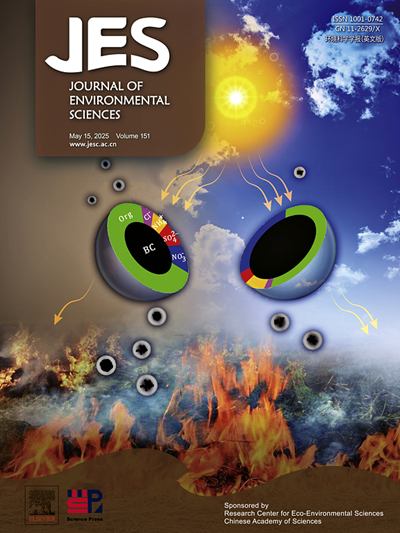Distinct performance and mechanism of microbial fuel cells-constructed wetland and direct-enchanced constructed wetland for levofloxacin removal
IF 6.3
2区 环境科学与生态学
Q1 ENVIRONMENTAL SCIENCES
引用次数: 0
Abstract
There is an urgent need to investigate the distinct performance and mechanism of traditional constructed wetland (CW), microbial fuel cells-constructed wetland (MFC-CW) and direct-enchanced constructed wetland (EC![]() CW) for antibiotics removal. To address this issues, three kinds of CWs were bulit and distinct performance and mechanism for levofloxacin (LVFX) removal was expored in this study. MFC
CW) for antibiotics removal. To address this issues, three kinds of CWs were bulit and distinct performance and mechanism for levofloxacin (LVFX) removal was expored in this study. MFC![]() CW, EC
CW, EC![]() CW achieved high LVFX removal efficiencies compared with traditional constructed wetland (96.0 % in MFC
CW achieved high LVFX removal efficiencies compared with traditional constructed wetland (96.0 % in MFC![]() CW, 95.0 % in EC
CW, 95.0 % in EC![]() CW and 91.2 % in CW) and the biodegradation was the key contributor (90.7 %-95.3 %). MFC
CW and 91.2 % in CW) and the biodegradation was the key contributor (90.7 %-95.3 %). MFC![]() CW is better capable to stimulate microbial activity and strengthen the removal effect of LVFX. MFC
CW is better capable to stimulate microbial activity and strengthen the removal effect of LVFX. MFC![]() CW performed well in reducing the effluent's ecotoxicity (dehydrogenase activity) and antibiotic resistance genes (ARGs). ARGs were mainly distributed in the anode region of MFC
CW performed well in reducing the effluent's ecotoxicity (dehydrogenase activity) and antibiotic resistance genes (ARGs). ARGs were mainly distributed in the anode region of MFC![]() CW while accumulating in the cathode region of EC
CW while accumulating in the cathode region of EC![]() CW. Atribacteria, Chlorobi, Synergistetes and Firmicutes significicant effect on the efficiencies of TN, NH4+, and LVFX. The core node for microbial community interaction in CW was only Pseudomonas in Proteobacteria (OTU4537). While MFC
CW. Atribacteria, Chlorobi, Synergistetes and Firmicutes significicant effect on the efficiencies of TN, NH4+, and LVFX. The core node for microbial community interaction in CW was only Pseudomonas in Proteobacteria (OTU4537). While MFC![]() CW included Opitutae_vadinHA64 (OTU3153) in Verrucomicrobia, Desulfomicrobium (OTU3629) in Proteobacteria, and Actinobacteria Gaiellales (OTU4206), and EC
CW included Opitutae_vadinHA64 (OTU3153) in Verrucomicrobia, Desulfomicrobium (OTU3629) in Proteobacteria, and Actinobacteria Gaiellales (OTU4206), and EC![]() CW included Mesotoga (OTU1104) in Thermotogae, Syntrophus (OTU3207) in Proteobacteria and Emticicia (OTU3788) in Bacteroidetes. MFC
CW included Mesotoga (OTU1104) in Thermotogae, Syntrophus (OTU3207) in Proteobacteria and Emticicia (OTU3788) in Bacteroidetes. MFC![]() CW and EC
CW and EC![]() CW increased the abundance of critical microbial communities, and the microbial communities were more closely related. This study improved the understanding of the molecular mechanisms underlying the enhancement of CW by the two bioelectrochemical methods.
CW increased the abundance of critical microbial communities, and the microbial communities were more closely related. This study improved the understanding of the molecular mechanisms underlying the enhancement of CW by the two bioelectrochemical methods.

微生物燃料电池-人工湿地和直接增强型人工湿地去除左氧氟沙星的不同性能和机理
研究传统人工湿地(CW)、微生物燃料电池-人工湿地(MFC-CW)和直接增强型人工湿地(ECCW)对抗生素去除效果的差异及其机理是当务之急。为了解决这一问题,本研究构建了三种CWs,并探讨了其去除左氧氟沙星(LVFX)的不同性能和机制。与传统人工湿地相比,MFCCW、ECCW对LVFX的去除率(MFCCW为96.0%、ECCW为95.0%、CW为91.2%)较高,生物降解是主要因素(90.7% ~ 95.3%)。MFCCW能更好地激发微生物活性,增强LVFX的去除效果。MFCCW在降低废水的生态毒性(脱氢酶活性)和抗生素抗性基因(ARGs)方面表现良好。ARGs主要分布在MFCCW的阳极区,而聚集在ECCW的阴极区。母门菌、绿藻菌、协同菌和厚壁菌门对TN、NH4+和LVFX的效率有显著影响。CW中微生物群落相互作用的核心节点仅为Proteobacteria中的Pseudomonas (OTU4537)。MFCCW包括Verrucomicrobia中的Opitutae_vadinHA64 (OTU3153)、Proteobacteria中的desulfomicroum (OTU3629)和Actinobacteria Gaiellales (OTU4206); ECCW包括Thermotogae中的Mesotoga (OTU1104)、Proteobacteria中的Syntrophus (OTU3207)和Bacteroidetes中的Emticicia (OTU3788)。MFCCW和ECCW增加了关键微生物群落的丰度,微生物群落的亲缘关系更密切。本研究提高了对两种生物电化学方法增强连续波的分子机制的理解。
本文章由计算机程序翻译,如有差异,请以英文原文为准。
求助全文
约1分钟内获得全文
求助全文
来源期刊

Journal of Environmental Sciences-china
环境科学-环境科学
CiteScore
13.70
自引率
0.00%
发文量
6354
审稿时长
2.6 months
期刊介绍:
The Journal of Environmental Sciences is an international journal started in 1989. The journal is devoted to publish original, peer-reviewed research papers on main aspects of environmental sciences, such as environmental chemistry, environmental biology, ecology, geosciences and environmental physics. Appropriate subjects include basic and applied research on atmospheric, terrestrial and aquatic environments, pollution control and abatement technology, conservation of natural resources, environmental health and toxicology. Announcements of international environmental science meetings and other recent information are also included.
 求助内容:
求助内容: 应助结果提醒方式:
应助结果提醒方式:


